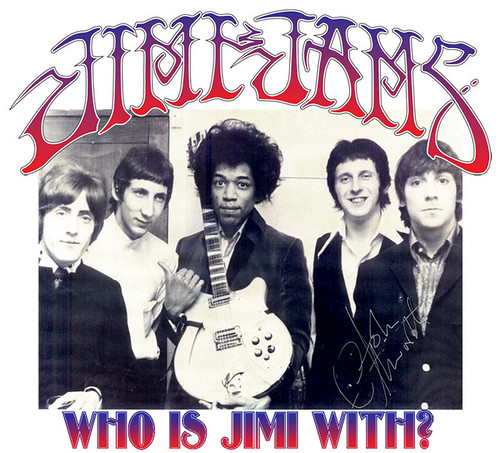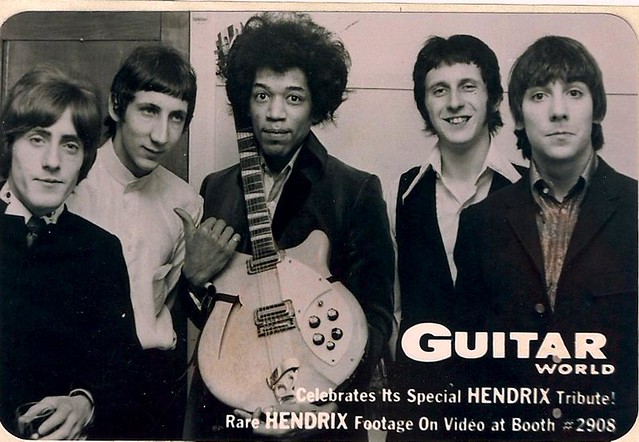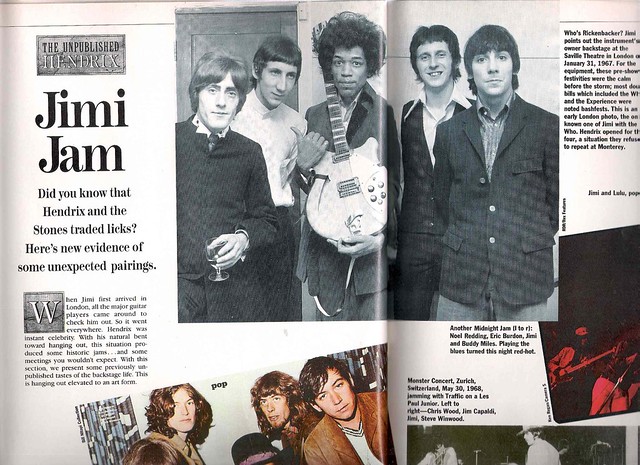I posted this artifact on FB ten years ago.
Ten years ago?!?! Help me tell this story. Who’s in??!?!Seriously ... sorry, some of these links don’t work. Will fix later, dig? (translation: guitarworld is part of Future plc, an international media group and leading digital publisher. Visit our corporate site. ... blah blah blah – in other words, I am shit out of luck. But ... praise be to my blog, Doctor Noe's Smooth Gadget, you can find some of this stuff here:
Tuesday, February 17, 2009
Jimi Hendrix, another nice shot found!
Yea, it's been 20 years since it came out... but we started working on that GW issue in Jan. 87.
Historic, no one has ever come close to that in any type of publication. I still remember the look on the face of the publisher Dennis Page coming into our office upon realizing we spent almost $10,000 on photos for a single issue. But GW '88 is still looked upon by collectors as the greatest accumulation of Hendrix photos in a single magazine or book.
Thanks again ... the first of two Big-ass Hendrix Special Issues that I edited as the editor of Guitar World, Sept. '85, was the first of two monumental Hendrix tributes, and the discussion of two V's Jimi was associated with can be found here:
GW Sept. 85 Axology Flying V P. 54
GW Sept. 85 Axology Flying V P. 55
Now dig this about the cover shot ...
I posted a plethora of Jimi juiciness on my Flickr page, the first one of which is referred to as
Jimi: A Continuing Homage to the World's Greatest Musician
That's where this story begins.
A photo of Jimi Hendrix, looking right at the camera with his rare flowered Flying V slung casually around his neck and wearing a powder-blue outfit. This special print is rare indeed because it was used in production for this issue. The photo credit for the cover is Jean-Pierre Leloir.
THIS PIC IS NOT A LASER REPRINT BUT A GENUINE PRODUCTION CHROMALYN WITH PRINTER’S MARKS INDICATING SIZING FOR PUBLICATION. More interestingly, the chromalyn – a one-of-a-kind limited-edition print – shows how the original photo by renowned photographer Jean-Pierre Leloir was masked to create the cover image you see above. At a 2009 exhibit at the Celebrity Vault gallery in Los Angeles, “HENDRIX REVEALED: A LIFE THROUGH THE LENS,” photos from Leloir’s shoot went for thousands of dollars.
The pic was used as the cover for the March 1988 Special Issue of Guitar World (for more info about the Collector’s Editions of Guitar World, you have to go to to my Flickr pages that tell more of the fascinating story (http://www.flickr.com/photos/doctor_noe/2567714905/).
Guitar World HENDRIX LIVES!: THE UNPUBLISHED HENDRIX, VOL. II of March, 1988 is the ultimate tribute to Jimi which I daresay has never been eclipsed, even as today, the publishers of Guitar World have just released another one:
But enough of this nitpicking, picking nits was never what it was about for me, I am about the icons of history, so here, without ado, is the history:
>"}}}}”> Noë Gold, aka Noe the G, is the Founding Editor of Guitar World magazine. Among his most cherished achievements is the creation, with partner Bill Nitopi, curator of the Hendrix Collection Archives and an editor-at-large of Guitar World, of two humongous Special Issues: Vol. 6, No. 5 SEPTEMBER, 1985 SPECIAL JIMI HENDRIX TRIBUTE! and Vol. 9, No. 2 MARCH 1988 THE UNPUBLISHED HENDRIX.
Noë Gold is a frequent contributor to MusicUCanSee magazine, Fandango and BestClassicBands. He was Features Editor at the Hollywood Reporter, editor-in-chief of Movies USA, LA Family, LA Times Custom Publishing, Bikini, Founding Editor of Guitar World, Hollywood Correspondent for Jing Daily and a columnist for the Village Voice and the New York Daily News. His entertainment news column, The Daily Fix, was a regular feature of the AOL Entertainment Channel. Noë's hallmark as an editor is building community. He is also a keen observer of the scene and a formidable writer-researcher. Author of articles and books on the music of Jimi Hendrix, Frank Zappa, Ry Cooder, Miles Davis, Stevie Ray Vaughan, Albert King and Jaco Pastorius, among others.
Noe Gold blogs at Doctor Noe's Smooth Gadget doctornoemedia.blogspot.com.










































